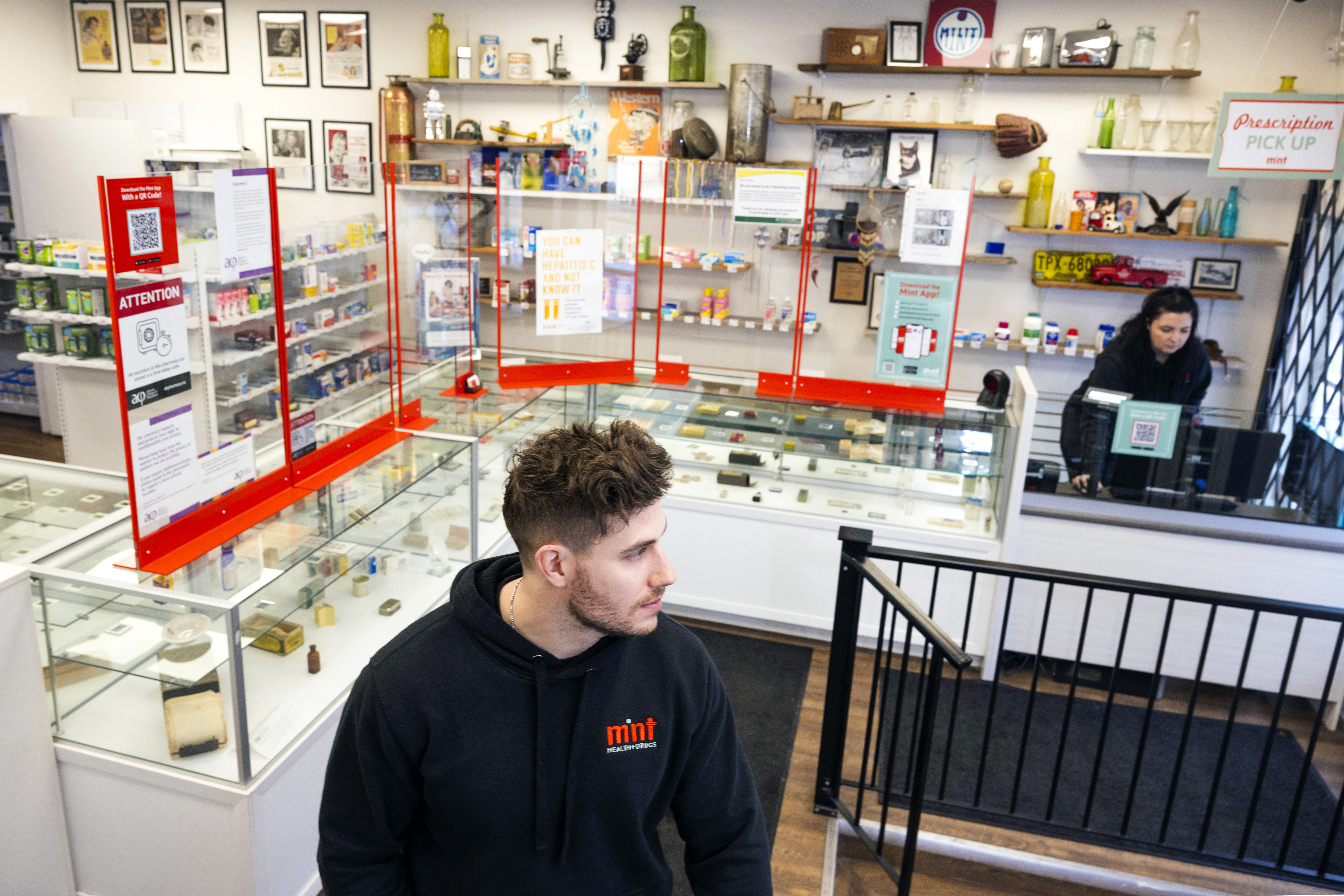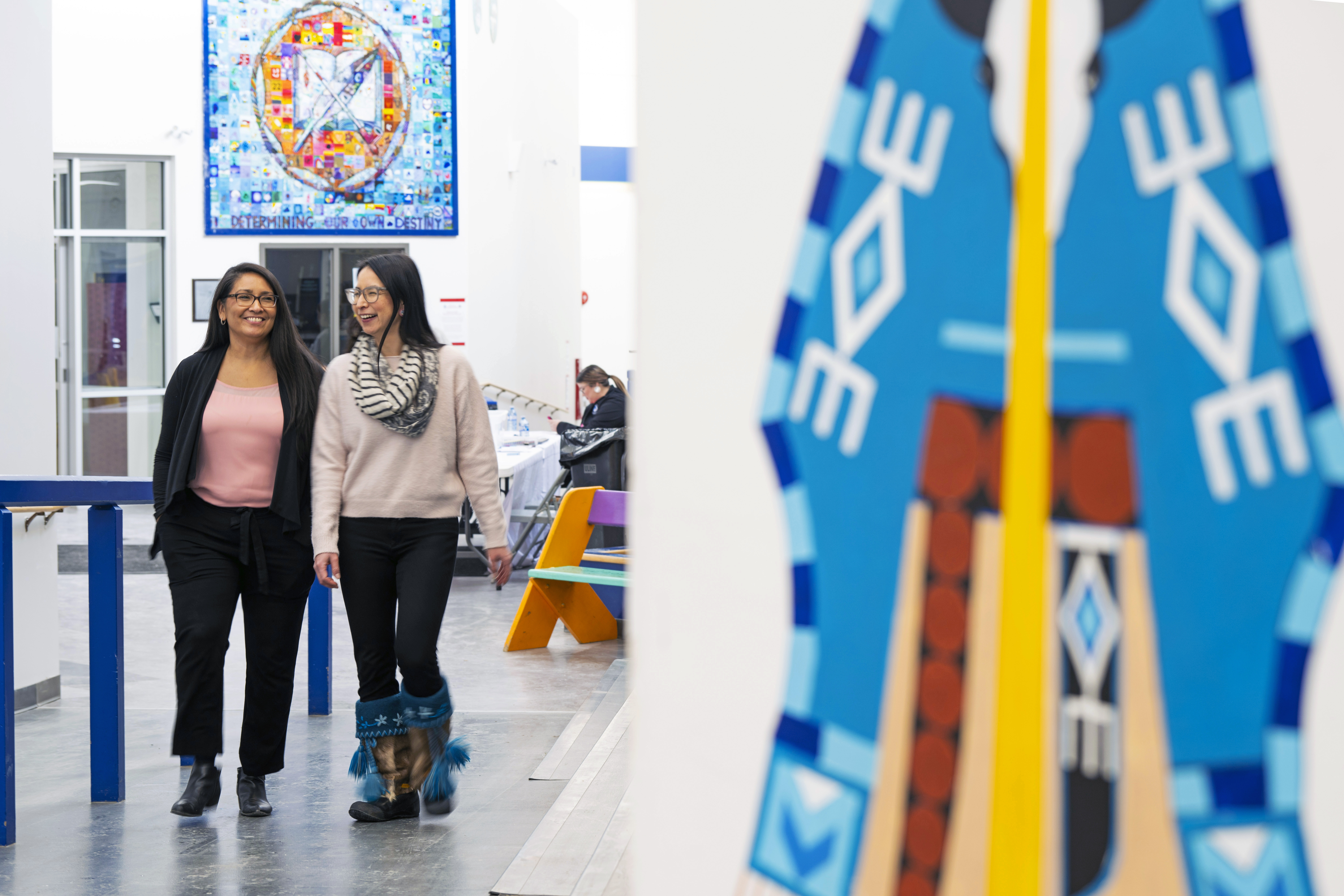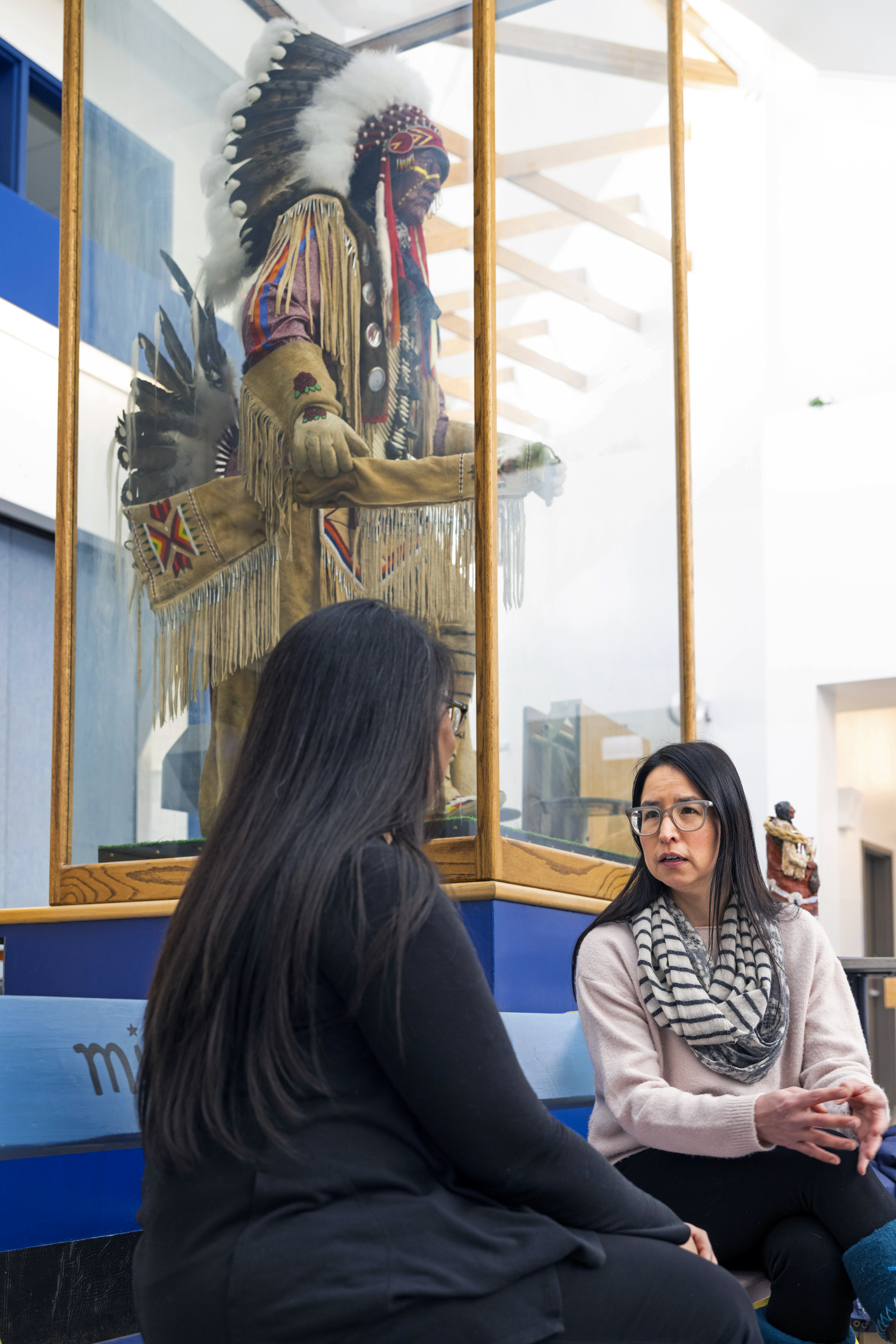Care for Communities
Lisa Catterall Photos by John Ulan - 21 March 2024

“When we opened here, I knew full well the challenges we’d face — and that the concentration of issues to deal with would be outside of our scope,” says Cole Mondor, ’15 BSc(Pharm).
Mondor is the pharmacist owner of Mint Health + Drugs in Edmonton’s central McCauley neighbourhood. McCauley is a historic area of town, one that the Edmonton Social Planning Council in 2017 described as “an inner-city neighbourhood northeast of downtown (that) has a disproportionately high percentage of social housing. More than half of housing in the area is below market rate.”
Mondor has seen first-hand the challenges that marginalized urban populations face on a day-to-day basis. He knew working as a community pharmacist in the downtown neighbourhood would mean long hours, difficult cases and at times frustration, but it was a challenge he was ready to face.
“I feel like the issues that we deal with here are more substantial in nature than what you might encounter in a typical community pharmacy. And after I started to experience that and realize it, I just couldn’t see myself working anywhere else.”
Mondor is not alone. In the nearly 1,600 community pharmacies across Alberta, pharmacists like him have become a core part of the neighbourhoods they serve, developing strong relationships and a deep understanding of the people who rely on their services.
Bridging the Gaps in Care
Navigating the Canadian health-care system can be challenging, with more than 6.5 million Canadians without regular access to a family doctor, according to OurCare, a pan-Canadian organization dedicated to discussing the future of primary care from the perspective of patients and the public. That gap can make it feel impossible to know where to turn for sound health advice, support with prescriptions or disease screening.
In Alberta, pharmacists are helping to close those gaps in the health-care system. They have one of the broadest scopes of practice in the world, providing access to services such as vaccinations, referrals, prescribing and refilling medications — services that would have once required an appointment with a family doctor.
Pharmacists are among the most easily accessible members of a patient’s health-care team, with evidence published in 2018 in the Canadian Pharmacists Journal showing that patients consult them between 1.5 and 10 times more often than they see their physicians. This accessibility is especially important in areas where patients lack access to other forms of primary care or have complex, sometimes conflicting needs. Socio-demographic factors such as race, education level and income can act as barriers to a patient’s ability to access health care. And few communities face the level of overlapping barriers to health care as those marginalized neighbourhoods where issues like addiction, homelessness and income inequality overlap to create complex patient needs.
For many people who work in Edmonton’s marginalized downtown core — whether they’re outreach workers, retail staff or pharmacists — work often means wearing many different hats to help others in the community. Some days, that might mean providing an ear to someone needing emotional or psychological support. On other days it might include helping someone secure housing or manage a medical emergency. For Mondor, work means thinking outside the scope of traditional pharmacy to help patients meet their basic needs.
“Often for our patients, the last priority is taking their medication in a compliant and reliable manner — that falls well below the list of more important things, like whether or not they have somewhere to stay, whether or not they have food to put in their stomach, whether or not they are safe and warm,” he says. “All of these basic human needs come before thinking about the future and their health and longevity and the medication to support that.”

Not Just Any Community Pharmacy
Mint’s McCauley location hardly looks like what one might expect of a traditional pharmacy. The bright, open space in the historic Phyllis Grocery building is quirky and inviting, the walls lined with vintage signs and antique memorabilia. But there are also elements of a more typical pharmacy setting, including over-the-counter medications on display behind the cash register, naloxone kits available on the front counter and a private patient counselling room in the back.
Just as Mint doesn’t look like a typical pharmacy, the services it offers patients are out of the ordinary. Since opening the location in 2017, Mondor and his team have routinely taken steps outside the traditional scope of their roles to support the health and overall well-being of patients in need.
Through its adherence and community engagement — or ACE — teams, the pharmacy has pioneered efforts to help neighbourhood residents do more than simply access health care. The team helps them meet basic needs, navigate government services and address other social challenges, whether that’s helping them find and afford baby formula or locating a lost dog.
The three-person ACE teams are made up of a pharmacist, nurse and social worker who work together and use a wraparound support model to respond to a wide variety of patient needs, including health, social, financial security or other needs. There’s an ACE team at work 365 days a year, serving a caseload of 40 to 45 patients at a given time. In many of those cases, the ACE team goes above and beyond to ensure patients get the support they need.
“If the patient is lucky enough to have living accommodations, they’ll see them there,” Mondor says of the ACE teams. “But they’ll often go to shelters to see patients or they’ll traverse down into the river valley in the middle of winter and slip all the way down the hill to find a specific patient because they know they’re camping out there.” Many of the area’s residents who are unhoused camp in the river valley.
“Put simply, they go to meet patients where they’re at.”
Proactive Rather Than Reactive Care
Every year, there are approximately two million visits paid to Alberta emergency departments. Some estimates indicate that up to 20 per cent of these could be avoided by providing patients with better access to primary health care.
As front-line workers, the ACE team aims to provide some of that primary health care. Their efforts are intended to help reduce the public cost of health care by taking preventive, proactive measures to support a patient’s health, rather than waiting to respond until their health has declined.
“Rather than having the patient go to emergency because they’re in painful acute withdrawal and need methadone, ACE is there ensuring they’re getting that medication,” Mondor says. The medication helps patients avoid going into withdrawal and the unpleasant physical and mental side-effects that come with it, including nausea, vomiting, chills or shakes, pain and irritability. By avoiding withdrawal, patients are then less likely to need to access the emergency room to manage their symptoms.
“In essence, it’s giving clients enough supports that they don’t feel the need to unnecessarily access and overburden other health resources.”
Community pharmacists like Mondor are positioned to support patients by building trusting relationships with them. That base layer of trust can improve both patient satisfaction and health outcomes — a lesson Mondor learned early on, when he realized that if he wanted to make a difference in patients’ lives, he would first need to establish a relationship built on trust and respect.
“They needed to see me as an ally in their overall well-being before I started to have the opportunity to discuss their health with them,” he says. “Their default mode is survival and they’re often distrusting of new people. So approaching people from that standpoint led to the understanding that they just need to feel safe around you.”

At the Core of Every Community
Much like Mondor, pharmacist Amber Ruben, ’06 BSc(Pharm), is well aware of the importance of building trusting relationships in community pharmacy. Although she works primarily as a hospital pharmacist, she’s in the midst of completing a research project examining the relationships of community pharmacists with patients — particularly in the context of Indigenous communities.
The project began to take shape in 2021, when Ruben began her master of science degree at the University of Alberta with a focus on Indigenous health. As an Inuvialuit pharmacist, she wanted to increase the academic understanding of relationships between Indigenous Peoples and community pharmacists. It was an area of study, she says, that had gone largely unexplored. Ruben saw it as a chance to understand gaps and inequalities in health care for Indigenous Peoples while building capacity and understanding among front-line health-care providers.
“Relationship is very important to Indigenous Peoples. That’s maybe a bit of a pan-Indigenous approach, but relationality is important across all cultures. And within pharmacy, there’s the concept that we are using pharmaceutical care, which places a patient at the centre of that care,” Ruben says.
“So there was a recognition that it was really important to take a look from an Indigenous community’s point of view about how they see relationships with community pharmacists, because they are so accessible to patients.”
In the fall of that first year of graduate school, Ruben met Jody Kootenay, a PhD student and a member of the Alexander First Nation, a Cree nation located less than an hour’s drive northwest of Edmonton. The pair were taking an Indigenous methodology course, examining approaches, practices and principles that had been used to research Indigenous communities in the past.
In the methodology course, Kootenay discussed how the Alexander First Nation had already been working with academic researchers for more than a decade. The community even had a long-standing administrative body to guide that work: the Alexander Research Committee. Kootenay says the committee was founded to support research in education and childhood health outcomes for children in Alexander First Nation.
In the years that followed the formation of the research committee, the First Nation partnered with academic researchers on a range of projects that were seen as beneficial to the community, usually having to do with education or health care.
“We kind of shaped the way the research unfolded for Alexander at that time because there was such a history of research written about us negatively. We wanted to change the way research was presented and done in First Nations,” Kootenay says.
As she listened to Kootenay, Ruben saw an opportunity in the First Nation’s willingness to partner with researchers and approached the research committee with her initial graduate school project proposal, explaining how she wanted to gather information from First Nation members about their views of their relationships with community pharmacists, including such topics as trust, patient expectations and pharmacists’ willingness to discuss traditional medicines.
Likewise, Kootenay saw the value of Ruben’s proposal almost immediately.
“I thought this type of research would benefit not just Alexander … but, more importantly, First Nations communities generally,” Kootenay says. She says she hopes Ruben’s project will affect practice and policy and shape the way pharmacists do their work.

Reconciliation Through Research
Access to health care in Indigenous communities is a topic inextricably linked to Canada’s colonial history. Residential schools, the Sixties Scoop and the reservation system are just part of the history that has shaped the way Indigenous Peoples have gained access to and interacted with Canada’s health-care system.
Ruben’s research touches directly on the Truth and Reconciliation Commission’s Call to Action #19, to identify and close the gaps in health outcomes in Indigenous communities. It also touches on the treaty right to health: that is, written and oral promises included in the negotiations for the numbered treaties across Canada that relate to ensuring health and medical services to First Nations people.
For Ruben’s supervisor, Cheryl Sadowski, this historical context gives the research project a special significance.
“It’s more than just a project, and it has great weight because it is about social justice and reconciliation,” says Sadowski.
“This is the first time we have a graduate student who is Indigenous in the faculty, and we have the opportunity to set a course for the profession and those who follow.”
As researchers, Ruben and Sadowski are sensitive to the fact that neither of them is a member of the Alexander First Nation. As they moved through the research process, they wanted to gain insight and perspective, while being careful to not perpetuate past wrongs. In essence, they wanted this work to be done with Alexander, not to Alexander.
To help with that, they hired a research assistant from the First Nation to support their work and ensure their research was being done in a culturally sensitive and appropriate manner.
“I’m an outsider to the community. We both are,” Ruben says. “So it was really important to bring in a research assistant to show that honouring Cree ideas and the Cree worldview is very important. (The First Nation membership of Alexander consists mostly of Cree with some Stoney descendancy.)
“I think it will really help in providing the results and showing that perspective in a way that we as outsiders couldn’t have.”
Sadowski also sees the Alexander Research Committee’s involvement throughout the process as an important evolution in research co-design in pharmaceutical studies. Sadowski and Ruben are the academic researchers leading the project, but the Alexander Research Committee has an integral role in steering the work. The voices of committee members carry equal, and sometimes greater, weight than those of the researchers.
“When we do presentations, they co-present with us. We are not presenting on their behalf. They’re contributing,” she says. “They’re not just helping us interpret; they are doing the work with us. It genuinely is a partnership.”
Just the Beginning
 The research project, which received a $25,000 grant from the federal Social Sciences and Humanities Research Council, is still underway. As Ruben works through the analysis phase of the project, the researchers continue to see great promise in the work.
The research project, which received a $25,000 grant from the federal Social Sciences and Humanities Research Council, is still underway. As Ruben works through the analysis phase of the project, the researchers continue to see great promise in the work.
For Kootenay, the project could fundamentally transform the relationships that Indigenous Peoples in Alexander — and across the country — have with community pharmacists.
“I’m hoping to see that practices are changed, that there’s some education with pharmacists about First Nations people that come to get medication, for example. That they know a little bit about me and a little bit about my treaty rights,” Kootenay says.
“I’m hoping that not only are pharmacists understanding some of those historical impacts and that context, but they’re also encouraged and wanting to build those relationships so that I don’t always have to go to my doctor for these things.”
Ruben also sees this work as a starting point: not just for First Nations members to build better relationships with pharmacists but also for academic researchers to find better ways to work in partnership with diverse communities.
“This is just a starting point,” Ruben says. “It’s the first step that we’ll see from the U of A’s Faculty of Pharmacy and Pharmaceutical Sciences in what is a good future of doing more collaborative work with communities like this.”